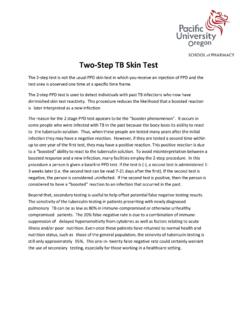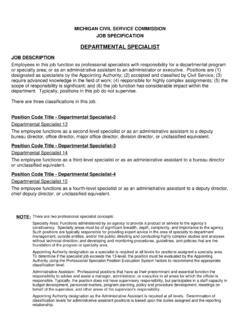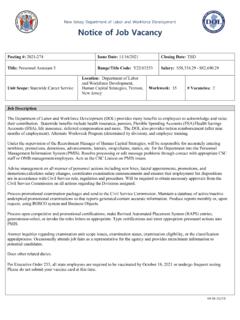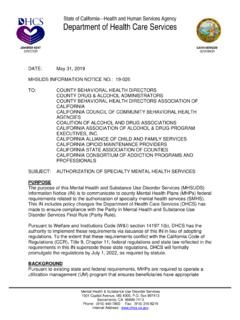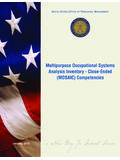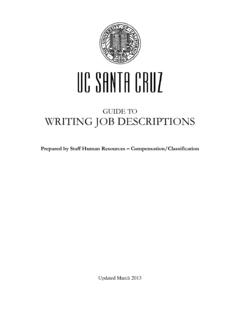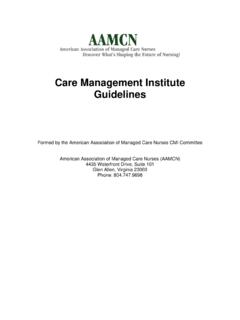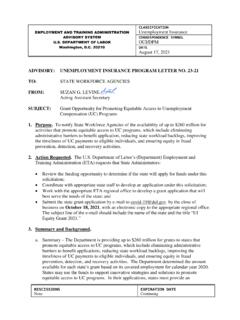Transcription of AOTA Scope of Practice - Pacific University
1 Scope of Practice American Occupational Therapy Association 1 Scope OF Practice Statement of Purpose The purpose of this document is to define the Scope of Practice in occupational therapy in order to 1. delineate the domain of occupational therapy Practice that directs the focus and actions of services provided by occupational therapists and occupational therapy assistants; 2. delineate the dynamic process of occupational therapy evaluation and intervention services to achieve outcomes that support the participation of clients in their everyday life activities (occupations); 3. describe the education and certification requirements to Practice as an occupational therapist and occupational therapy assistant; and 4. inform consumers, health care providers, educators, the community, funding agencies, payers, referral sources, and policymakers regarding the Scope of occupational therapy.
2 Introduction The occupational therapy Scope of Practice is based on the American Occupational Therapy Association (AOTA) document Occupational Therapy Practice Framework: Domain and Process (AOTA, 2002) and on the Philosophical Base of Occupational Therapy, which states that the understanding and use of occupations shall be at the central core of occupational therapy Practice , education, and research (AOTA, 2003a, Policy ). Occupational therapy is a dynamic and evolving profession that is responsive to consumer needs and to emerging knowledge and research. This Scope of Practice document is designed to support and be used in conjunction with the Definition of Occupational Therapy Practice for the Model Practice Act (AOTA, 2004a).
3 While this Scope of Practice document helps support state laws and regulations that govern the Practice of occupational therapy, it does not supercede those existing laws and other regulatory requirements. Occupational therapists and occupational therapy assistants are required to abide by statutes and regulations when providing occupational therapy services. State laws and other regulatory requirements typically include statements about educational requirements to Practice occupational therapy, procedures to Practice occupational therapy legally within the defined area of jurisdiction, the definition and Scope of occupational therapy Practice , and supervision requirements. AOTA (1994) states that a referral is not required for the provision of occupational therapy services (p.)
4 1034); however, a referral may be indicated by some state laws and other regulatory requirements. The AOTA 1994 document Statement of Occupational Therapy Referral states that occupational therapists respond to requests for services, whatever their sources. They may accept and enter cases at their own professional discretion and based on their own level of competency (p. 1034). Occupational therapy assistants provide services under the supervision of an occupational therapist. State laws and other regulatory requirements should be viewed as minimum criteria to Practice occupational therapy. Ethical guidelines that ensure safe and effective delivery of occupational therapy services to clients always influence occupational therapy Practice (AOTA, 2000).
5 Scope of Practice American Occupational Therapy Association 2 Definition of Occupational Therapy AOTA s Definition of Occupational Therapy for the Model Practice Act defines occupational therapy as the therapeutic use of everyday life activities (occupations) with individuals or groups for the purpose of participation in roles and situations in home, school, workplace, community, and other settings. Occupational therapy services are provided for the purpose of promoting health and wellness and to those who have or are at risk for developing an illness, injury, disease, disorder, condition, impairment, disability, activity limitation, or participation restriction. Occupational therapy addresses the physical, cognitive, psychosocial, sensory, and other aspects of performance in a variety of contexts to support engagement in everyday life activities that affect health, well-being, and quality of life (AOTA, 2004a).
6 Scope of Practice The Domain and Process The Scope of Practice includes the domain and process of occupational therapy services. These concepts are intertwined with the domain defining the focus of occupational therapy (see Figure 1) and the process defining the delivery of occupational therapy (see Figure 2). The domain of occupational therapy is the everyday life activities (occupations) that people find meaningful and purposeful. Within this domain, occupational therapy services enable clients to engage (participate) in their everyday life activities in their desired roles, context, and life situations. Clients may be individuals, groups, communities, or populations. The occupations in which clients engage occur throughout the life span and include activities of daily living (self-care activities); education (activities to participate as a learner in a learning environment); instrumental activities of daily living (multistep activities to care for self and others, such as household management, financial management, and childcare); leisure (nonobligatory, discretionary, and intrinsically rewarding activities); play (spontaneous and organized activities that promote pleasure, amusement, and diversion); social participation (activities expected of individuals or individuals interacting with others).
7 And work (employment-related and volunteer activities) Scope of Practice American Occupational Therapy Association 3 DOMAIN OF OCCUPATIONAL THERAPY Engagement in Occupation to Support Participation in Context or Contexts Performance in Areas of Occupation Activities of Daily Living (ADL)* Instrumental Activities of Daily Living (IADL) Education Work Play Leisure Social Participation Performance Skills Performance Patterns Motor Skills Habits Process Skills Routines Communication/Interaction Skills Roles Context Activity Demands Client Factors Cultural Objects Used and Their Properties Body Functions1 Physical Space Demands Body Structures2 Social Social Demands Personal Sequencing and Timing Spiritual Required Actions Temporal Required Body Functions Virtual Required Body Structures *Also referred to as basic
8 Activities of daily living (BADL) and personal activities of daily living (PADL). (AOTA, 2002, p. 611) 1 Body Functions ( , neuromuscular, sensory, visual, perceptual, cognitive, mental) 2 Body Structures ( , cardiovascular, digestive, integumentary systems) Figure 1 Within this domain of Practice , occupational therapists and occupational therapy assistants consider the repertoire of occupations in which the client engages, the performance skills and patterns the client uses, the contexts influencing engagement, the features and demands of the activity, and the client s body functions and structures. Occupational therapists and occupational therapy assistants use their knowledge and skills to help clients attain and resume daily life activities that support function and health throughout the lifespan (AOTA, 2002, p.)
9 610). Participation in activities and occupations that are meaningful to the client involves emotional, psychosocial, cognitive, and physical aspects of performance. This participation provides a means to enhance health, well-being, and life satisfaction. The domain of occupational therapy Practice complements the World Health Organization s (WHO) conceptualization of participation and health articulated in the International Classification of Functioning, Disability and Health (ICF) (WHO, 2001). Occupational therapy incorporates the basic constructs of ICF, including environment, participation, activities, and body structures and functions, when addressing the complexity and richness of occupations and occupational engagement. Scope of Practice American Occupational Therapy Association 4 The process of occupational therapy relates to service delivery (see Figure 2) and includes evaluating, intervening, and targeting outcomes.
10 Occupation remains central to the occupational therapy process. It is client-centered, involving collaboration with the client throughout each aspect of service delivery. During the evaluation, the therapist develops an occupational profile, analyzes the client s ability to carry out everyday life activities, and determines the client s occupational needs, problems, and priorities for intervention. Evaluation and intervention may address one or more of the domains (see Figure 1) that influence occupational performance. Intervention includes planning and implementing occupational therapy services and involves therapeutic use of self, activities, and occupations, as well as consultation and education. The occupational therapist and occupational therapy assistant utilize occupation-based theories, frames of reference, evidence, and clinical reasoning to guide the intervention (AOTA, 2002).






